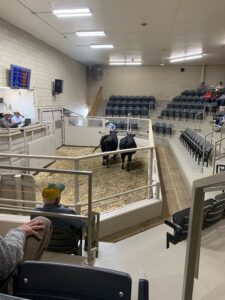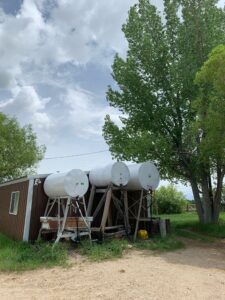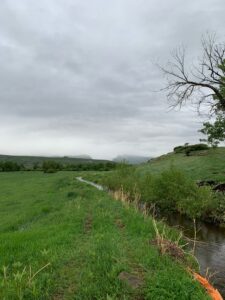Experience at the Sale Barn
#bfrdpwy #aginternship #RightRisk

This week I had a lot more time to go over, improve on, and learn about flood irrigation and pipe irrigation. I also spent a day with Jim at a sales barn and learned about how sale barns operate. For the last half of one of my days, I also painted our fuel tanks with reflective paint, along with spending some time building fences and monitoring water levels throughout the ranch due to some heavy rain we got.
With the amount of rain that had been covering a large portion of the ranch, as well as the waterways we utilize to irrigate, we had to watch and adjust how open several of our water gates were. Watergates are a contraption that can control how much water is diverted away from larger moving bodies of water. This helps with irrigating, flood prevention, and even lessening debris in agricultural fields. They can also help us to get a general measurement of how much water we are using, along with measuring tapes and markers submerged and posted within supplying moving water ditches. Factoring weather into farming is something that nearly everyone knows about, either from a first-person experience to seeing shortages in certain crops or headlines in mainstream news. Jim tries to continue irrigating regardless of weather though because weather is unreliable and cannot be a major factor when it comes to production. It is crucial to look over the entirety of the ranch and its many streams, ditches, and canals in order to keep a mental log of how much water we have to use and if we have to check on certain areas more often to prevent blowouts happening within any of the water movements so that flooding and loss of water doesn’t occur.

Overall, I learned a lot about topics that I had previously been introduced to; it was essential to continue to grow my understanding and thought process with irrigation, especially since I have been doing the majority on my own. One thing that I think could be more efficient is how we handle splitting water when a ditch that separates into two individual avenues. Currently, we completely block one channel and let the water move down only one avenues. Some of the water will run down the blocked channel, but at an extremely low volume. It takes more time to get both routes properly irrigated because we have to do them separately, one after the other. My proposal would be to allow the water to reach a higher volume and flow through both avenues collectively rather than splitting up the process. It would reduce the amount of time needed to irrigate a larger area and reduce the number of dams that would be needed since we wouldn’t have one channel with dry dams sitting along with the blocking dam for one of the ditches.
On another note, from this week, being able to get off of the ranch to learn about the ins and outs of a sales barn was amazing. They often have a livestock class schedule, traditionally with cattle as the largest class or portion. My host was there to potentially purchase a horse, until we were informed by the barn owner and auctioneer about a medical issue. Jim gave me a crash course in things to know about selecting cattle or horses (the only available classes) such as how to tell cattle age. This was great information to be exposed to and absorb.

One of the biggest questions that I had from this week mainly had to focus on the day we spent at the sales barn. There was one horse that we had gone to bet on and hoped to take back to the ranch. Prior to the auction starting, the horse appeared to be a great prospect with good body conditioning and temperament. However, during his time up for auction it was revealed that he had navicular, which is a hoof disease in horses. While we were looking through the pens of available horses, the cards that gave slight descriptions of them were incredibly vague. My question is, why isn’t there more information given about the listed animals and more of a background on them? Having this information up front would help the buyers and give them a more well-rounded perspective when it comes time to bid.
Moving forward and into next week, I plan to use more of the general experience and understanding of dam placement and timing to improve my decisions in certain pastures that we are currently irrigating. I also plan to speed up certain pasture watering in areas with a more improved plan for the dam placements and with the increased amount of water we have received after a few days of rain. I intend to have better spacing and pressure when it comes to irrigating with pipes in two of the pastures we are currently trying to run through, and increase water coverage in as little time as possible.

Submitted by: Olivia Halter
Edits by: GrowinG Internship Team


